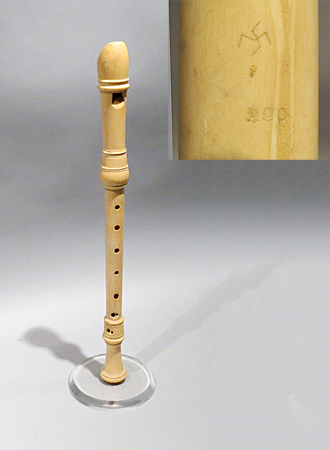
Owner: HWMC
Catalog#: 2CL-AEBH-03
Flutes - Recorders
Baroque Alto Recorder in ‘F’
Possibly France
Check engraving below:
Ivory, wood, cork
ca. 1720’s
Length: 36 in; top diameter: 2.5 in; Bell diameter: 3 in
Wind Instruments – Woodwind Instruments – Flutes – Recorders
Stamped maker’s mark on all three pieces: ‘S’ superimposed over an ‘M’ / R 90
This Baroque alto recorder in ‘F’ is made of ivory. It has stylized molding and cork inlay where the pieces fit together. In the middle of the mouthpiece is a section of dark wood. A maker’s mark which appears to be an S superimposed over an M, or the other way around is shown on each of the three pieces. Underneath the initials/logo marking is possibly an ‘R’ with the number 90. Baroque recorders, like the alto seen here, were constructed of three detachable joints and had a brighter and more colorful sound than the Renaissance instruments. This recorder has a thumbhole and six fingerholes on main joint, one fingerhole on the foot joint (fingerholes 6 and 7 are both doubled).
Historical records indicate that the recorder first appeared in the Middle Ages and was a pipe called ‘recordour’, dating from ca. 1388. These instruments played vocal music or other instrumental parts. They remained a popular instrument during the Renaissance and Baroque periods in Europe. During the Baroque Era, the French name for the instrument was flute douce, or simply flute, In the Classical and Romantic Era there was rarely, if any mention of the recorder. Then, during the mid-20th century it resubmerged as part of the historically informed performance movement and even became a popular instrument in elementary education. Today there are many professional and amateur recorder players with consorts/ensembles notably found in various colleges and universities in addition to community groups.
Resources: Baines, Anthony (1957). Woodwind Instruments and Their History; Rowland-Jones, Anthony (Autumn 2016). “The Invention of the Recorder”. The Recorder Magazine. Vol. 36 no. 3. Hebden Bridge: Peacock Press. p. 81.
